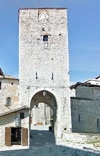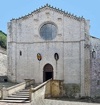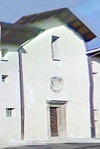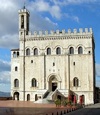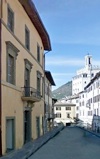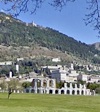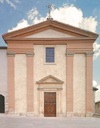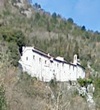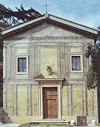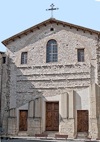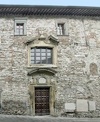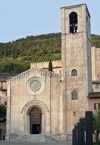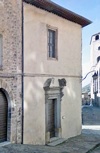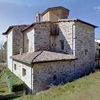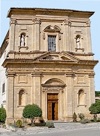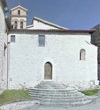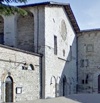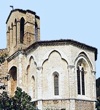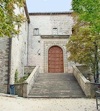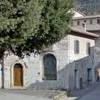City Walls and Gates
This page sets out how the city walls of Gubbio developed from pre-Roman times. It includes a short description of each of the surviving gates:
-
✴Arco di San Marziale, inside the medieval city; and
-
✴six gates in the medieval circuit:
-
•Porta Castello;
-
•Porta Metauro;
-
•Porta di San Ubaldo (or Porta dell’ Angelo);
-
•Porta Romana (illustrated here);
-
•the double gate of Porta di San Pietro and Porta Vittoria; and
-
•Porta degli Ortacci.
Duomo (ca. 1188)
This page describes the old Duomo, which was probably on near the present church of San Giovanni Battista (below), and its successor. Both were dedicated to SS Marianus and James, Numidian martyrs whose relics are preserved under the present high altar.
Eremo di Fonte Avellana (late 10th century)
This hermitage played a leading role in the religious life of Gubbio from its inception. St Peter Damian was its prior from ca. 1043 until his death in ca. 1072, and the hermitage was a leading light in the reformation of the Church throughout this period. It was at the head of the Benedictine Congregation of Fonte Avellana from 1076 until 1569. It was then absorbed into the Camaldolesian Order, to which it still belongs.
Hospitals of Gubbio
-
✴the precursors of the Spedale Grande:
-
•the Ospedale della Misericordia (1326), illustrated here;
-
•the Ospedale Nuovo di Sant’ Agostino (1410) and its predecessor, the Ospedale Vecchio di Sant’ Agostino (1349);
-
•the Ospedale di Santa Maria della Carità (1295); and
-
•the Ospedale dei Calzolari (14th century ?);
-
✴the Spedale Grande (1505); and
-
✴its two successor institutions:
-
•the Infermeria Nuova (1628); and
-
•the Ospedale Grande Rinnovato (1746-66).
Nunneries of Gubbio
-
✴Sant’ Antonio da Padova (???); ;
-
✴Monastero del Buon Gesù (or delle Cappuccine, late 16th century);
-
✴Sant’ Elisabetta (???); and
-
✴Santa Lucia (1226), illustrated here; and
The nunneries of: San Benedetto; San Marziale and Santa Chiara (which merged in 1787); Santo Spirito and Santissima Trinità each has its own page (below).
Public Palaces of Gubbio
-
✴Palazzo Comunale (late 12th century), the remains of which have been excavated under Palazzo Ducale (below);
-
✴two quasi-public palaces that were probably built by the Guelfs of Gubbio in the early 14th century:
-
•the so-called Palazzo del Capitano; and
-
•the so-called Palazzo del Bargello; and
-
✴the “new” public palaces that were built following a decision of 1321:
-
•Palazzo dei Consoli (1332-42), illustrated here; and
-
•Palazzo del Podestà (ca. 1338-49), which is also known as Palazzo del Pretorio.
-
This page also described the pensile Piazza Grande between these last two palaces, which formed part of the plan of 1321 but which was not built until 1480-3.
Palazzo dei Canonici and Palazzo Vescovile
This page describes two palaces associated with the Duomo:
-
✴Palazzo dei Canonici (early 13th century);
-
✴Palazzo Vescovile (rebuilt in the 18th century), illustrated here.
Palazzo Ducale (1476-80)
Duke Federico da Montefeltro built this palace almost immediately after the completion of his main palace in Urbino. Its architect, probably Francesco di Giorgio Martini, succeeded brilliantly in coping with the pre-existing medieval structures and the difficult site. The passed by marriage to the Medici family of Florence in 1631 and entered into a long period of decline. It reverted to State ownership in 1957 and has been restored. The famous intarsia and painted panels from the
studiolo have been dispersed, but the room has recently been adorned with excellent replicas.
Patrician Palaces of Gubbio
-
✴Palazzo Accoromboni (16th century), illustrated here;
-
✴Palazzo Barbi (16th century);
-
✴Palazzo Beni (late 14th century);
-
✴Palazzo Benveduti (18th century);
-
✴the so-called Palazzo Gabrielli (late 13th century);
-
✴[Palazzo Marini (17th century)];
-
✴Palazzo Pamphili (16th century);
-
✴Palazzo della Porta (begun in 1495); and
-
✴Palazzo Toschi Mosca (17th century).
Palazzo Ranghiasci-Brancaleoni (1820-41)
This palace overlooking Piazza Grande incorporates a number of older buildings. It was owned for a period to the Galeotto family, and housed the Zecca (mint) of Gubbio in 1626-1759. Giacomo Ranghiasci acquired it in 1820. His nephew Francesco acquired it on his marriage in 1827 to Matilde Hobhouse and built the present neo-Classical façade in 1841.
This page also describes the associated Parco Ranghiasci-Brancaleoni (1831-49), which Francesco apparently designed to the taste of his English wife.
“Percorso Archeologico”
The archaeological area of Gubbio extends for some 25 acres
outside Porta degli Ortacci, across the area known as Guastuglia. Tickets are available in the Antiquarium (see also museums), which stands on the site of an excavated Roman domus. The signed itinerary also includes:
-
✴the Roman theatre (illustrated here);
-
✴the Roman mausoleum; and
-
✴the wider archeological area of la Guastuglia.
Sant' Agostino (1250-92)
The nascent community of Augustinian hermits was established here in 1250, shortly before the formal institution of their Order. The church and convent seem to have been completed by 1292. The friars were expelled after the unification of Italy in 1860 but managed to return in 1901.
Sant’ Ambrogio (1342)
Bishop Pietro Gabrielli built this hermitage for the hermits who were living in the surrounding mountains. It absorbed the canons of San Secondo in 1413 and became part of the new Congregation of the Most Holy Saviour soon after. The relics of the Blessed Angelo Canetoli, who moved here in 1498 and died in 1513, are preserved under the high altar.
San Benedetto (1731-3)
The Benedictine monastery here passed to the Olivetans from San Donato (see “Other Monuments” below) in 1425 and then to the poor Clares of the Monastero di Santa Maria del Pellagioin 1519. The nuns received permission to rebuild their church in 1731 and commissioned a number of works for it from some of the leading artists in Rome.[Suppression ?] The complex now belongs to the Comune di Gubbio, and houses the Laboratorio Multimediale "Gola del Bottaccione".
Santa Croce della Foce (1262)
This church outside the walls belongs to the Confraternita di Santa Croce della Foce, which was first documented in the 15th century, and which has presided over the annual Good Friday procession in Gubbio since at least that time.
San Domenico (late 13th century)
The church stands on the site of San Martino, which was first documented the 11th century and which gave its name of this area of the city. The Dominicans began the present church ion the site and extended it for the first time in 1339. It took on its present form in the 15th century, when the last bay of the nave was demolished. The interior largely dates to 1765. [Suppression ??] The church now serves the surrounding parish.
San Filippo Neri (1646-7)
The Oratorian Fathers moved here in 1649. The church was re-modelled in 1739. It passed to the Congregation of the Most Holy Redeemer
in 178 and then to the Confraternita del Suffragio at Santa Maria del Prato in 1832. The church was restored and entrusted to the Knights of the Holy Sepulchre in 2010
San Francesco (1259-92)
The Spadalunga family, who had known St Francis, gave a house and warehouse on this site to his followers at Santa Maria Vittorina (below) in ca. 1240
. The friars subsequently built the church and adjacent convent here. The community was suppressed in 1866 but was able to return 25 years later.
San Giovanni Battista (late 13th century)
This church replaced an earlier one with the same dedication that formed part of the episcopal complex of Gubbio. It housed an important relic of St John the Baptist, the co-patron of Gubbio until 1263. A chapel in the church was adapted to serve as the baptistry in 1828, when the celebration of the feast of St John the Baptist was reinstated in Gubbio. The relic was subsequently moved back to San Giovanni Battista, probably in 1913.
San Giovanni Decollato (ca. 1509)
This site originally formed part of a complex owned by the Confraternita dei Disciplinati del Crocifisso di Sant’ Agostino. The brothers retained it when they sold most of the complex to the nuns of SS Trinità in 1505, and built a new church here some four years later. Towards the end of the 16th century, it passed to the Confraternita della Buona Morte (or dei Neri), which was dedicated to bringing comfort to prisoners, and particularly to those condemned to death. (The church is also known as San Giovanni dei Neri). The complex was transferred to the Famiglia dei Santantoniari in 1974.
San Girolamo (ca. 1625)
Text
[Temporary link to San Girolamo]
San Giuseppe dei Falegnami (1686-91)
Santa Maria dei Laici (1325)
The Confraternita della Beata Vergine Maria (also known as the Confraternita dei Bianchi or dei Laici) built this church and the adjacent hospice (later the Ospedale della Misericordia, see above). The church reopened as a museum after a long restoration in 2010.
Santa Maria Nuova (late 13th century)
This church, which was first documented in 1292, belonged to the monks of Santa Maria d’ Alfiolo outside Gubbio until 1439, when it passed to the friars of nearby Sant’ Agostino (above). The Collegiata di Santa Cristina (see “Other Monuments” below) used the church in the period
1725-1825 to Santa Maria dei Servi (when it was dedicated as Santa Maria Addolorata e Santa Cristina). The church was deconsecrated in the early 20th century and used to store works of art from other churches. It can be visited by appointment.
Santa Maria della Piaggiola (1613-25)
The Confraternita della Piaggiola built this church
to house an image known as the Madonna della Piaggiola (“la piaggia” signifies a hillside) from their nearby oratory. It was closed in 1786 when the confraternity was suppressed, but it was nevertheless restored after the earthquake of 1984. It reopened in 1997 and its altarpieces, which had been removed for restoration, were returned in the following year.
Santa Maria del Ponte (1570)
This church is named for the nearby Ponte di San Donato. The Confraternita della Beata Vergine built it to house a Marian fresco that was to be detached from a wayside tabernacle on the site. It became a parish church in 1983 and is administered by the canons of San Secondo (below).
Santa Maria del Prato (1662-70)
A small church here, which stood on the presumed site of the home of the Blessed Sperandio (died 1260), belonged to the nuns of the nearby Monastero di Santa Maria del Paradiso. When the nuns moved to a new nunnery, Santo Spirito(below) in 1468, the ownership of the church moved with them. An image of the Madonna and Child here was reported to have performed miracles. in 1662, and the present church was built to house it. Bishop Alessandro Sperelli, who became remained the prime mover in the project, arranged for it to be translated to the new high altar.
Santa Maria del Suffragio (1601)
Bishop Andrea Sorbolonghi agreed that all donations made to the existing Marian oratory on this site could be used to build this new church, which was to be administered by a new confraternity, the Confraternita del Suffragio. It became a parish church in 1984.
Santa Maria della Vittoria (13th century)
This church, which is also known as the Chiesa della Vittorina, was probably named for the nearby Roman road, Via Vittorina. The famous meeting of St Francis and the wolf of Gubbio is said to have occurred in nearby woods in 1206. The monks of the Abbazia di San Pietro (below), who then owned the church, gave it to the first Franciscans in Gubbio, who built a simple hermitage nearby. The friars moved to san Francesco (above) in ca. 1240. Santa Maria della Vittoria passed to a community of Poor Clares, who lived here until 1514.
San Marziale, originally Sant' Andrea (11th century)
This complex includes the church and two adjacent nunneries:
-
✴the Monastero di San Marziale (1365); and
-
✴the Monastero di Santa Chiara (ca. 1378).
The nunneries merged in 1787, when the combined nunnery became known as the Monastero di Santa Maria del Carmine. This community was suppressed in 1808-14 and again in 1860, althoughthe existing nuns were allowed to remain. They managed to buy it in 1903 but it closed in 1989. It is being adapted for residential use.
San Pietro (11th century)
The first Benedictine abbey was established here perhaps as early as the 8th century, on the site of a very early building. It was first documented in 1092. It became extremely powerful and had jurisdiction over an extended area. Its many possessions were confirmed in the privileges that the Emperor Frederick I granted to Gubbio in 1163. It belonged to the Cassinese Congregation until ca. 1505, when it passed to the Olivetans. When this congreagtion was suppressed in 1831, San Pietro passed to the Camaldolesians of the Eremo di Fonte Avellana (above). The monastery was suppressed in 1861 and its church now serves the surrounding parish. The ex-monastery has housed the Biblioteca Sperelliana since 2010.
San Secondo (14th century)
According to tradition, the widow Eudoxia Gabrielli built the first church on this site early in the 4th century to house the relics of the martyr St Secondus, who had been martyred in Amelia in the reign of the Emperor Diocletian. It subsequently acquired the relics of SS Secundinus and Agapitus, probably from Christians fleeing the Vandal invasion of Africa in ca. 500. St Ubaldus studied at San Secondo as a child in the late 12th century. It was administered by a community of Augustinian canons from 1142
. It was merged with the canonical community at Sant’ Ambrogio (above) in 1413 and incorporated into the Canonical Congregation of San Salvatore of Bologna soon after. The community was suppressed in 1810 but was able to return five years later. It joined the Regular Order of Lateran Canons at about this time.
Santo Spirito (15th century)
This church and nunnery stands on what was the site of the Ospedale di Spirito Santo, which was first documented in 1221. The site passed to the nuns from Monastero di Santa Maria del Paradiso (see Santa Maria del Prato, above) in 1468. The nunnery was closed in 1905. A cinema now occupies the original church, and the complex also houses the Centro Convegni Santo Spirit. A number of interesting frescoes (early 16th century) survive in the Cappella del Rosario in the garden behind the main building,
[Temporary link to the Monastero di Santo Spirito]
Santissima Trinità (1410)
Text
[Temporary link to the Monastero di SS Trinità]
Sant’ Ubaldo (1513-27)
The relics of St Ubaldus were translated from the Duomo to a small oratory on this site at the summit of Monte Ingino in 1194
. Duke Guidobaldo I planned the present church shortly before his death in 1508, and the project was continued his widow, Elisabetta Gonzaga and her niece, Eleonore. The basilica, which was originally administered by community of Lateran Canons,
passed to the Congregation of the Passion of Jesus Christ in 1787. It was suppressed in the Naploleonic period and then passed to theFranciscans in 1816. They were expelled during the period 1860-1910, and when they returned they undertook a significant programme of restoration (1915-23). They left in 2013 and the basilica now belongs to the Diocesi di Gubbio.
Other Monuments
-
✴In Walk I:
-
•San Bernardino (ca. 1467), illustrated here;
-
•Chiesa della Misericordia (1590);
-
•Collegiata di Santa Cristina (1639);
-
•Santa Croce del Mercato (13th century);
-
•San Francesco della Pace (1618);
-
•San Francesco di Paola (1659-64);
-
•San Giuliano (12th century);
-
•Santa Maria degli Angeli (ca. 1630);
-
•Santa Maria dei Servi (1340-3);
-
•Santa Maria del Suffragio (17th century);
-
•Conservatorio delle Orfanelle (ca. 1780); and
-
•Teatro Comunale (1738).
-
✴In Walk II:
-
•San Donato alla Foce (13th century)
-
•San Felicissimo (10th century); and
-
•San Nicolò dei Cappuccini (1635-48).
-
✴In Excursions from Gubbio:
-
•San Bartolomeo (1o57);
-
•Sant’ Emiliano in Congiuntoli (11th century);
-
•San Girolamo di Monte Cucco (11th century);
-
•Santa Maria di Sitria (11th century); and
-
•San Verecondo di Vallingegno (13th century).
Return to the home page on Gubbio.


